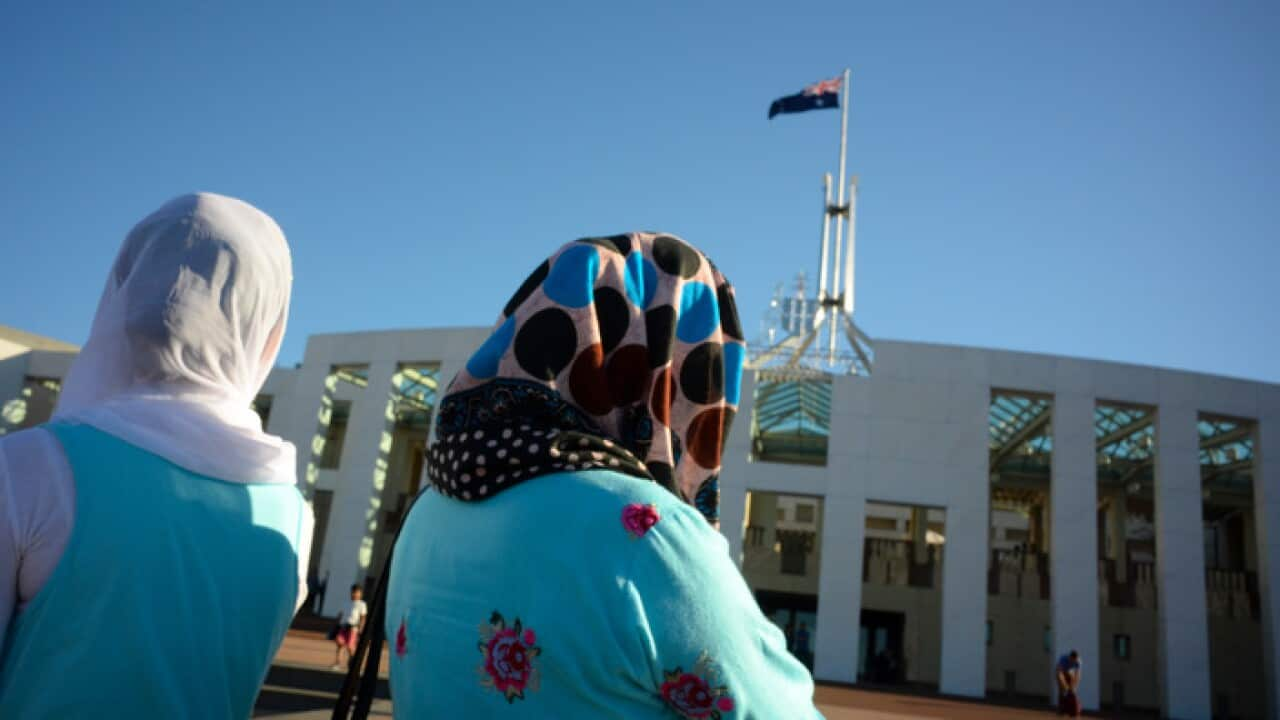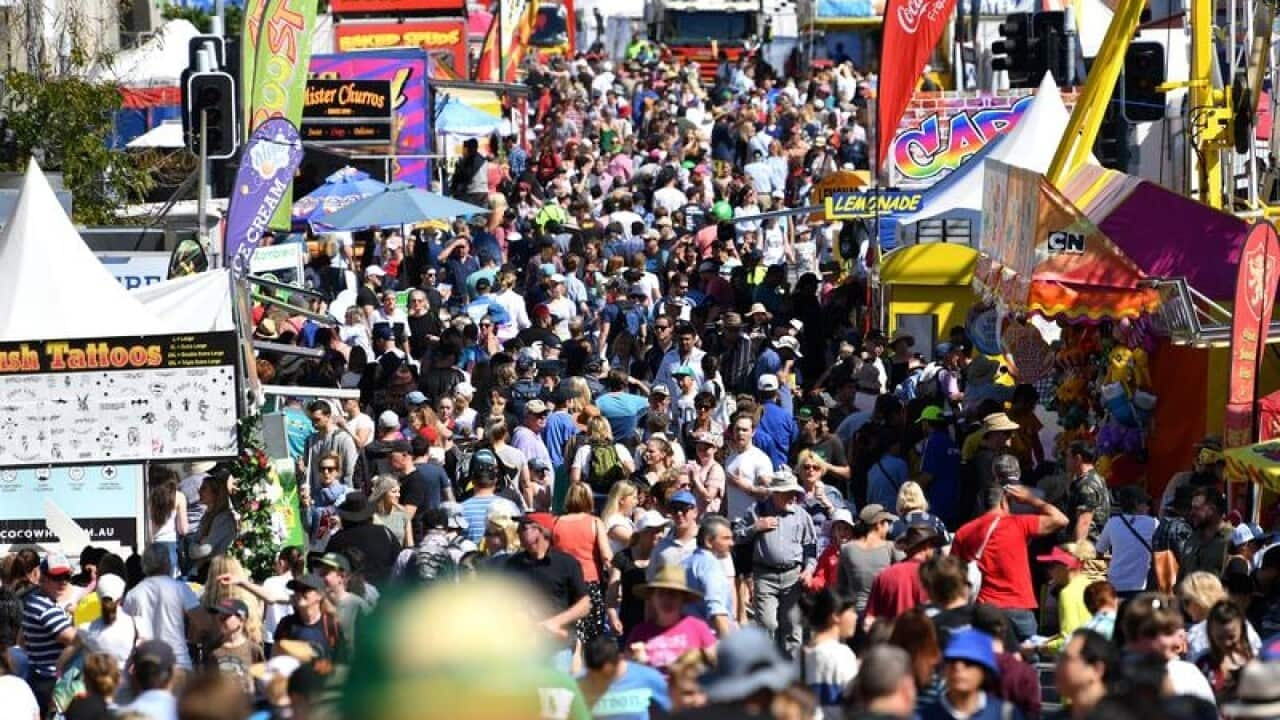Prime Minister Malcolm Turnbull likes to say that . And while that might gloss over the country’s history of racial exclusion (and the three senators from anti-immigration party One Nation in federal parliament), contemporary Australia .
That’s because Australia has a higher proportion of people born overseas (26 per cent) than other high-immigration nations, including New Zealand (23 per cent), Canada (22 per cent), the United States (14 per cent), and the United Kingdom (13 per cent). In fact, the only country that has a higher overseas-born population is (32 per cent) which permits foreigners to work but does not offer permanent residency or citizenship.
Since 1945, when Australia’s immigration department was established, seven permanent migrants have settled in Australia.

1945: Private Ian Hamilton Clark of the Australian Imperial Force and his Russian wife Olga contemplate passage to Australia from London. Source: Picture Post/Getty Images
Today's Australia
revealed a diverse nation. Nearly half of all Australians were born overseas or have at least one parent who was. More than one in five Australians speak a language other than English at home. The most common countries of birth after Australia were England (five per cent of the population) and New Zealand (2.5 per cent), followed by China (2.3 per cent) and India (2.1 per cent). Since the mid-2000s, Chinese and Indian arrivals have outpaced arrivals from the UK and migration has replaced births as the driver of population growth.

Children carry Australian and Indian flags during the Australia Day Parade on January 26, 2015 in Adelaide. Source: newzulu.com/Getty Images
Immigration nation
Country of birth
Multiculturalism has been official Australian policy since the early 1970s and it enjoys broad support. Over 80 per cent of people in Australia say multiculturalism has been good for the country, according to the past four years of the conducted by Monash University.
Ancient origins
DNA evidence suggests the first people to migrate to the Australian continent most likely came from South-East Asia between 40,000 and 60,000 years ago, according to . Estimates of the size of the Aboriginal population before European settlement range between 300,000 and 1.5 million: some 600 tribes speaking more than 200 distinct languages.
Today Aboriginal and Torres Strait Islander people account for 2.8 per cent of the country's 24 million people.

The Department of Immigration's timeline of early migration to Australia. Source: Department of Immigration
The 1800s: First modern migrants
Most of the first modern migrants ti Australia were involuntary arrivals: British convicts sent to the penal colony of New South Wales. Until the mid-1800s, the population was dominated by British and Irish people. But the discovery of gold near Orange, NSW, in 1851 triggered a gold rush that changed the face of Australia.
Between 1851 and 1860, more than 600,000 migrants arrived: most were from the UK but . Xenophobic hostility toward the newcomers focussed on the Chinese, whose different work practices were regarded as a threat to wages and employment, according to the Department of Immigration’s history. The tension resulted in anti-Chinese riots which resulted in several deaths, leading to the colonies’ first restrictions on immigration, targeting Chinese people.
Xenophobic hostility toward the newcomers focussed on the Chinese, whose different work practices were regarded as a threat to wages and employment, according to the Department of Immigration’s history. The tension resulted in anti-Chinese riots which resulted in several deaths, leading to the colonies’ first restrictions on immigration, targeting Chinese people.

Prospector sits in front of his prospectors hut in the gold rush in Fly Flat, Western Australia. Source: Universal Images Group Editorial/Getty Images
The potato famine in Ireland in the late 1840s , and the push to develop Australia’s outback led to a government decision .
Some 50,000 people, mostly men from Vanuatu and the Solomon Islands, in the primary industries in Queensland. Mostly brought against their will, many stayed on and built a community.
The 1900s: Federation and the White Australia Policy
At federation in 1901, three million people in the six colonies became the nation of Australia, and the new country’s parliament - - defined it as a white man’s nation.
The Immigration Restriction Act 1901 , aimed at discouraging non-white migrants. It included a notorious dictation test of 50 words in a European language - immigration officials could choose any language they pleased - which applicants had to pass to emigrate to Australia. Japanese pearl divers and Malay and Filipino boat crew were exempt from the test. who were forced to apply for documents to exempt them from the test if they travelled.

Major immigrant arrival groups by decade. Graph by .id The Population Experts, used with permission. Source: blog.id.com.au
The World Wars
Immigration virtually ceased during the first world war. But during the 1920s more than 340,000 immigrants arrived - two-thirds of them assisted migrants from Britain, and small numbers of Greeks, Italians and Yugoslavs.
The Great Depression, which began in 1929, saw unemployment rates skyrocket and attitudes towards immigrants turn hostile. Immigration declined sharply through the 1930s.
Ahead of the Second World War, as the political climate for Jews in Germany and Austria darkened, Australia agreed to accept 15,000 Jewish refugees from Europe - . Just 5,000 arrived in 1939 before Jews in Europe could no longer escape.
After the war, Australia appeared to take a more generous approach, agreeing to take refugees under the international Displaced Persons Scheme and admitting more than 170,000 Europeans by 1954. Over 17,000 of them were Jews.
The post-war migrant boom
In 1948, parliament legislated to create Australian citizenship - before that, all Australians were British subjects. But Australia still actively sought British migrants in preference to other nationalities, with ventures like the assisted passage scheme known as the "Ten Pound Pom" (the price of the ticket) kicking off in the late 1940s and running almost 25 years. But the post-war environment saw a significant shift in Australia’s attitude to migrants and set it on the path to multiculturalism. A national poll taken in 1943 found , driven in part by a critical labour shortage. The country’s first-ever immigration minister Arthur Calwell promoted the idea that Australia needed to “populate or perish".
But the post-war environment saw a significant shift in Australia’s attitude to migrants and set it on the path to multiculturalism. A national poll taken in 1943 found , driven in part by a critical labour shortage. The country’s first-ever immigration minister Arthur Calwell promoted the idea that Australia needed to “populate or perish".

18th October 1948: Migrant families wave goodbye from London airport as they leave Britain for new lives in Australia, using the assisted passage scheme. Source: Hulton Archive/Getty Images
Australia began accepting migrants from more than 30 European countries, including the Netherlands, Austria, Belgium, Spain and West Germany. But the largest national groups of arrivals after the Brits .
A new family reunion policy saw some 30,000 arrivals from Eastern European nations join relatives in Australia.
, a hydroelectricity scheme in south-east Australia that kicked off in 1949 and took 25 years to complete.
1950s: The end of the White Australia Policy
The dictation test was abolished in 1958. By 1960, the population was 10 million and around nine per cent of the population were of non-British origin, mostly Italians, Germans, Dutch, Greeks and Poles.
Other restrictions on non-European migration were relaxed from 1966 and the number of arrivals started to increase accordingly. Australia began to change rapidly. .  In 1973, Labor Prime Minister Gough Whitlam changed the law to allow all migrants regardless of race or ethnicity to apply for Australian citizenship after three years of residence. His immigration minister Al Grassby declared the White Australia Policy dead. he said.
In 1973, Labor Prime Minister Gough Whitlam changed the law to allow all migrants regardless of race or ethnicity to apply for Australian citizenship after three years of residence. His immigration minister Al Grassby declared the White Australia Policy dead. he said.

June 1954: Greek immigrants to Australia attend English lessons at the Bonnegilla Reception Centre near Alderbury, Victoria. Source: Picture Post/Getty Images
In 1975, racial discrimination was made illegal. Three years later, the publicly-funded (now known as SBS, publisher of this website) was established to cater to Australians of a non-English speaking background.
1970s-today: Asylum seekers, skilled migrants
Humanitarian intakes saw the settlement of Lebanese and Cypriot people during the early 1970s; followed by a significant wave of Indochinese arrivals displaced by the Vietnamese and Cambodian conflicts. Over 2,000 Indochinese refugees landed in boats on Australian shores in the late 1970s, but the majority of the 80,000 Indochinese permanent migrants came by air after they were formally processed by Australian officials at refugee camps in Malaysia and Thailand. From the late 1990s, increasing numbers of asylum seekers fleeing conflict in the Middle East and Sri Lanka arrived in Australia by boat, mostly organised by people smugglers. Australia’s government cracked down on what it called “unauthorised” arrivals. Its offshore detention programs, designed to deter asylum seekers, , but the "stop the boats" policy has retained strong bipartisan support.
From the late 1990s, increasing numbers of asylum seekers fleeing conflict in the Middle East and Sri Lanka arrived in Australia by boat, mostly organised by people smugglers. Australia’s government cracked down on what it called “unauthorised” arrivals. Its offshore detention programs, designed to deter asylum seekers, , but the "stop the boats" policy has retained strong bipartisan support.

A refugee Vietnamese family in their room at a reception hostel upon their arrival in Sydney, Australia c.1978. Source: Corbis Historical/Getty Images
In parallel with its hardline asylum policies, it's worth noting that Australia has thrown open its doors to migrants, with some settling each year for the past five years. Temporary arrivals including international students and those on 457 work visas were around . And the humanitarian intake has been about since the mid-1980s. There wasannounced in 2015 under former Prime Minister Tony Abbott in response to the war in Syria.
Since the 1980s, the focus of Australia’s immigration policy has been on selecting migrants who fit much-needed skills criteria, along with family visas. In 2017 the Turnbull government moved to restrict the skilled visa system and tighten requirements for citizenship, including reinstating a tough English-language test. But those changes have been put on ice after it became clear they did not have support in the Senate, leading to a  Sources: //, ,
Sources: //, ,

Aysha Kassem holds her young brother Ahmad Kassem during Eid al-Adha celebrations in Bankstown, Sydney, 2014. Source: Getty Images AsiaPac













